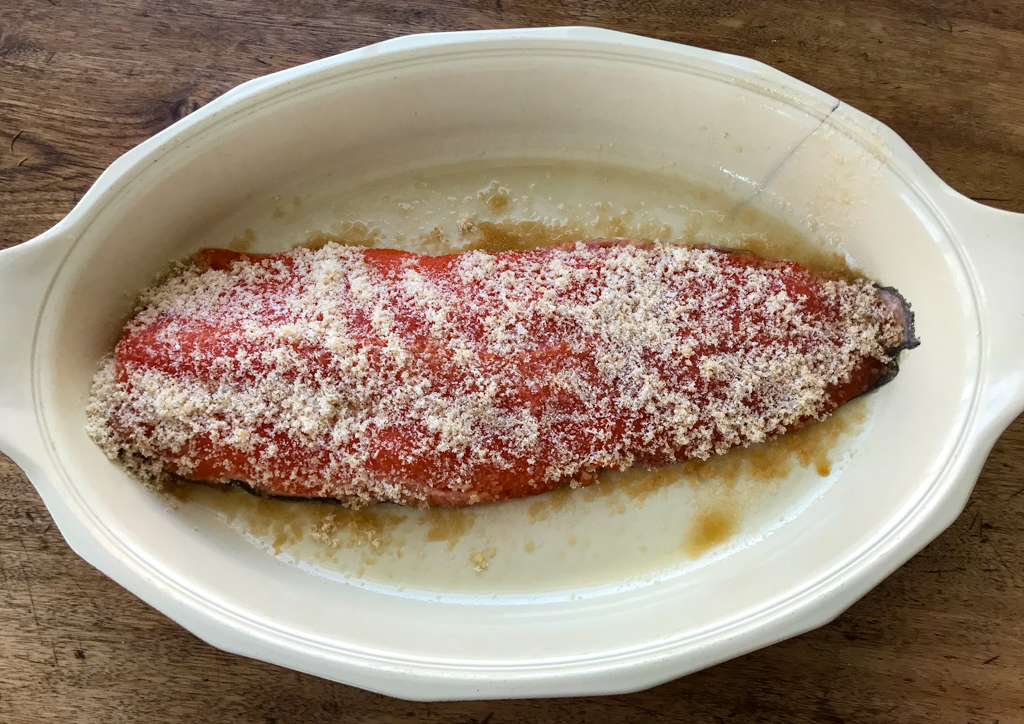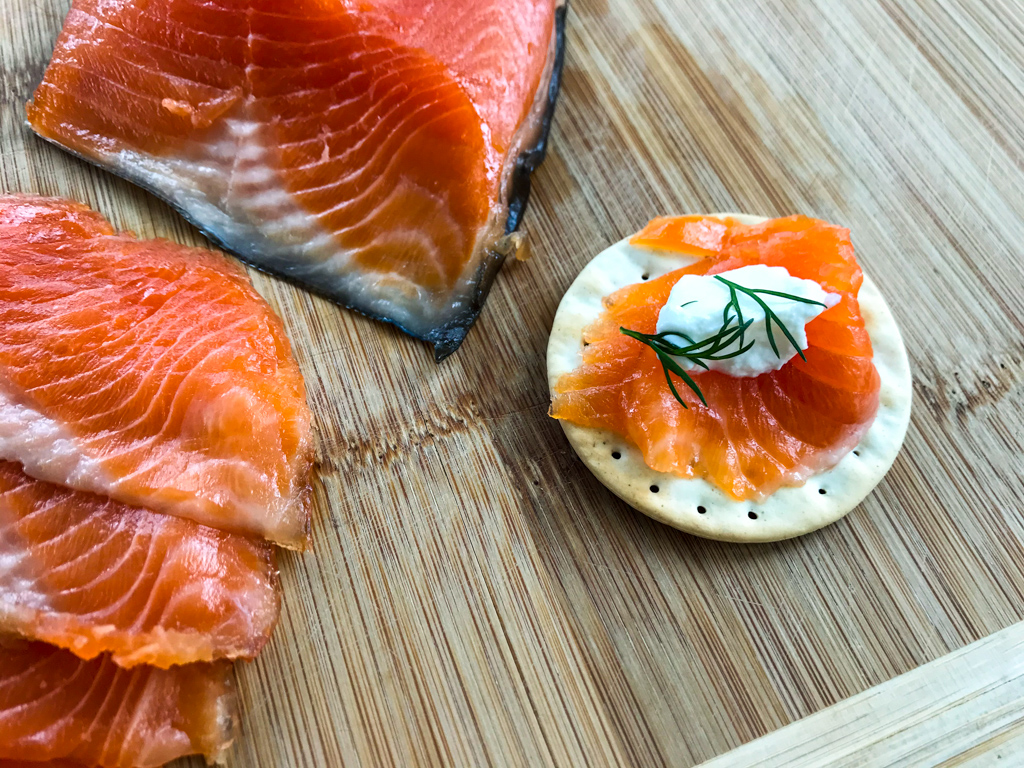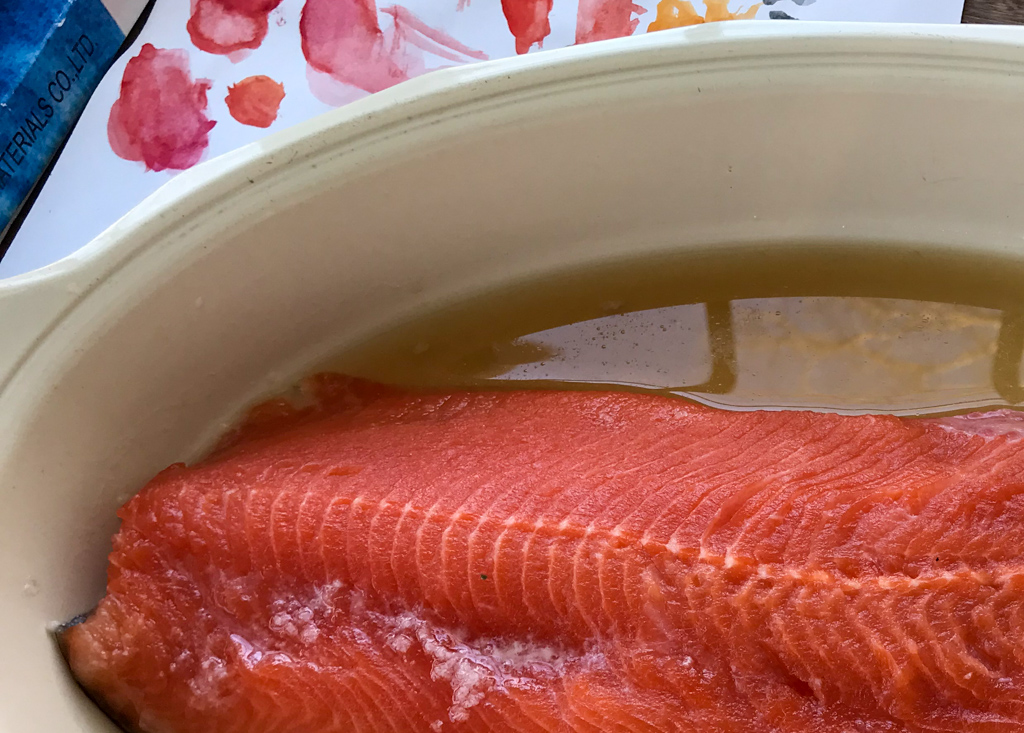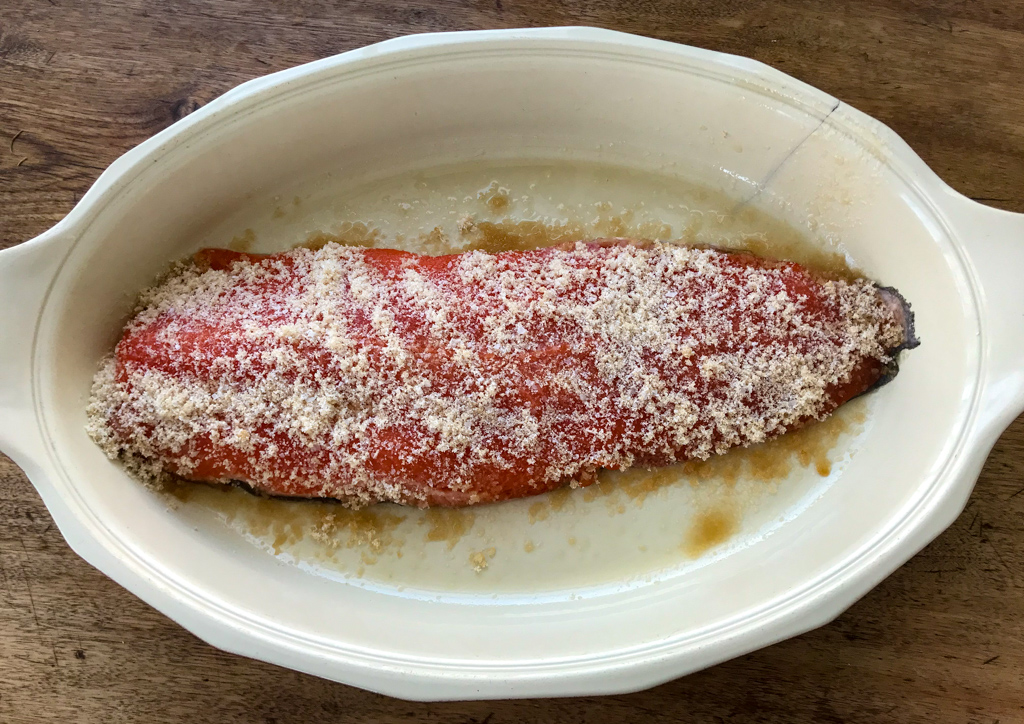
Lox, lachs, gravlax, smoked salmon – they’re all a bit scary to make the first time. Folks who sample the home-cured fish I serve them do often go nuts over it and ask for the recipe but they will rarely, rarely make it. Few want to take that big first step of shelling out for thirty or forty dollars worth of salmon and then just leaving it naked in the fridge for days. They worry about draining it, weighting it, flipping it, and eventually slicing it.
For all of you out there who would like to get addicted to cured fish but don’t know how to begin, let arctic char be your threshold drug. The farmed char I’ve been seeing these past few years is a terrific fish to treat to a simple salt cure. You don’t have to flip it or weight it, and the thinness of the flesh means it can be ready in as little as twenty-four hours. It’s also easier to slice into perfect, bagel-sized arcs.
Flavor-wise, char is a salmonid, and among that range of fishes it is on the more delicate, trout-y side. It doesn’t have the muscular flavor of wild-caught Pacific breeds like king or sockeye, but it’s as potent as all but the very best farm-raised Atlantic salmon, and has none of the fat issues. Those thick white streaks in some farm-raised salmon filets will melt and self-baste the pink flesh as it cooks, but a salt cure leaves them intact as the flesh shrinks, making them more prominent.
It is possible to make a farmed-salmon gravlax that is unpleasantly fatty – this is why folks trim off the belly flap. If you want to know what to do with that part and you don’t have a cat, it’s good rolled in salt and brown sugar and baked in a slow oven until quite firm. This is, more or less, what’s called salmon candy.
Char doesn’t have that problem. They’re plenty fatty, but closer to a wild sockeye than a bloated Atlantic farmboy fish. They’re also sold in incredibly convenient filets that weigh almost exactly one pound; they’re prepped to be reasonably free of belly membrane and pin bones, and (most) are sustainably farmed in freshwater tanks and raceways rather than the controversial open sea pens used for some salmon. Finally, like me, they take kindly to a drop of gin or tequila.
But the single greatest advantage of char as a cured fish is how quickly it’s made. To understand why, please know that the end goal of a salt-curing process is to pull out about 10% of the weight of the fish, or a little more, in water. Nothing else matters very much – weighing it down with bricks has minimal impact, and flipping is just silly. The work is all done by the salt and by dry, moving air.
A thick chunk of salmon can spend days in a fridge drying out, while a thin filet of char can be ready in as little as 18 hours. You can easily start curing a char filet on Saturday morning for a Sunday brunch, where it will nicely serve four.
This 24-Hour Charlax Recipe keeps things extremely simple. I do love a sprinkle of gin for the bushy, juniper aroma, but it’s hardly needed. I’m also well aware of the many recipes that ask you to lay on fresh dill stalks and lots of coarsely ground black pepper, but if you’re just beginning your charlax journey, start with a pure heart and a clean fish. By tomorrow morning, or the day after if you get a late start, you could be char’d.
24 Hour Charlox
A salmon gravlax made with arctic char, salt, brown sugar and gin - ready to eat in 24 hours.

Check out your fish! If the surface is at all sticky, rinse it briefly in cool water and pat dry. If there are significant pin bones or strips of belly membrane along the sides (unlikely in these farm-raised, farm-prepped fish), remove them with a pair of needlenose pliers or a sharp knife, respectively.
Lay the fish flesh side up in a baking dish with a bit of room at the sides. Sprinkle with two teaspoons of the gin, massaging it in lightly with your fingers. Mix together the salt and brown sugar in a small bowl. Sprinkle about two-thirds of the mixture on the fish and pat that out evenly as well, reserving the rest of the sprinkle. Cover with plastic wrap and refrigerate for 12 hours, or overnight.

When the time is up, you should have about two or three tablespoons of accumulated liquid. Peel back the plastic wrap, drain off the liquid, and then sprinkle on the remaining sugar and salt. Leave that on for 6 hours - or up to twelve, if you have the leisure. You'll see another tablespoon or so of liquid this second time; drain that off as well.
After draining the second time, rinse the fish briefly in cool water to wash off the remaining cure, then pat dry with a paper towel. Sprinkle with the remaining two teaspoons of gin and place in the fridge - uncovered! - on a rack or open plate for another six to twelve hours. You're now done, except for the slicing and serving. To store the fish, wrap in plastic, and then foil. It will keep for a week, at least, refrigerated.

Gratuities
We're giving you the option of a 24-hour charlox sprint, or a more leisurely 36-hour stint. You can let the fish cure longer, if you like a firmer style, but I think you'll find the timing is about right to get deli-style results. Served on its own, this home-cured charlox is indistinguishable from all but the best smoked salmon or gravlax.
The important bits in this ultra-simple recipe are, believe it or not, the second gin sprinkle and the final hours spent uncovered in the fridge. A refrigerator is also a dehumidifier, and those last hours not only pull out another 1% or 2% of water weight, they let the filet develop a smooth pellicle that will help preserve it, and give it a finished look. If you're up for a little cold smoking, this is when that would happen. The pellicle helps the smoke particles adhere.
I have used lots of different liquors in this recipe. It's the second sprinkle that really brings them out; don't omit that. A nice gin is the go-to, but tequila is also fine, as are citrus and licorice flavors. I have a Norwegian aquavit that suits the arctic gestalt, but have also gone with Cointreau, brandy, bourbon and scotch. Sometimes, as Julia Child would say, I even put it on the fish.

Ingredients
Directions
Check out your fish! If the surface is at all sticky, rinse it briefly in cool water and pat dry. If there are significant pin bones or strips of belly membrane along the sides (unlikely in these farm-raised, farm-prepped fish), remove them with a pair of needlenose pliers or a sharp knife, respectively.
Lay the fish flesh side up in a baking dish with a bit of room at the sides. Sprinkle with two teaspoons of the gin, massaging it in lightly with your fingers. Mix together the salt and brown sugar in a small bowl. Sprinkle about two-thirds of the mixture on the fish and pat that out evenly as well, reserving the rest of the sprinkle. Cover with plastic wrap and refrigerate for 12 hours, or overnight.

When the time is up, you should have about two or three tablespoons of accumulated liquid. Peel back the plastic wrap, drain off the liquid, and then sprinkle on the remaining sugar and salt. Leave that on for 6 hours - or up to twelve, if you have the leisure. You'll see another tablespoon or so of liquid this second time; drain that off as well.
After draining the second time, rinse the fish briefly in cool water to wash off the remaining cure, then pat dry with a paper towel. Sprinkle with the remaining two teaspoons of gin and place in the fridge - uncovered! - on a rack or open plate for another six to twelve hours. You're now done, except for the slicing and serving. To store the fish, wrap in plastic, and then foil. It will keep for a week, at least, refrigerated.

Gratuities
We're giving you the option of a 24-hour charlox sprint, or a more leisurely 36-hour stint. You can let the fish cure longer, if you like a firmer style, but I think you'll find the timing is about right to get deli-style results. Served on its own, this home-cured charlox is indistinguishable from all but the best smoked salmon or gravlax.
The important bits in this ultra-simple recipe are, believe it or not, the second gin sprinkle and the final hours spent uncovered in the fridge. A refrigerator is also a dehumidifier, and those last hours not only pull out another 1% or 2% of water weight, they let the filet develop a smooth pellicle that will help preserve it, and give it a finished look. If you're up for a little cold smoking, this is when that would happen. The pellicle helps the smoke particles adhere.
I have used lots of different liquors in this recipe. It's the second sprinkle that really brings them out; don't omit that. A nice gin is the go-to, but tequila is also fine, as are citrus and licorice flavors. I have a Norwegian aquavit that suits the arctic gestalt, but have also gone with Cointreau, brandy, bourbon and scotch. Sometimes, as Julia Child would say, I even put it on the fish.

